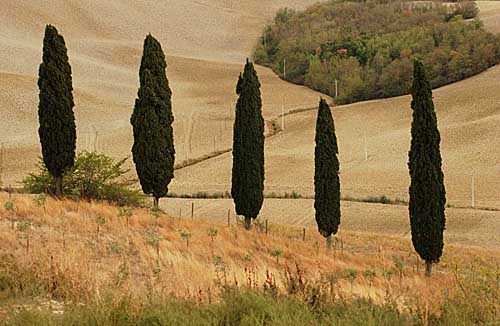 |
Palazzo Newsletter
October 13, 2008
|
 |
Palazzo Newsletter
October 13, 2008
|
| Tuscany A Timeless Landscape | In This Issue |
|
Page 1 Next Back to Palazzo |

Italy--every foreigner's dream--is a country steeped in religion, history, politics, art, culture, food and wine with Tuscany as the jewel of its crown. No visit is complete without a trip to this land of rolling hills, vineyards, sunflower fields, olive groves and hill towns. Tuscany is comprised of ten provinces as varied and distinct as the multitude of reasons to rediscover the appeal of this resplendent land. We are captivated by its rich traditions, beguiled by the rustic simplicity of its villages, and awed by the genteel sophistication of its cities. Like the pages of a favorite book revisited, Tuscany reveals itself in ways both familiar and different and beckons us to return time and again to fall in love anew. That's amore!
Mangia, Mangia, Mangia!!
"The cuisine of a country is the only exact attestation of its civilization." Arguably, perhaps no other country has so intimate a relationship to food that Italy has with its cuisine. Italians seriously love to eat and are equally joyous in feeding others. Every holiday or event, religious or secular, is indeed another festive opportunity to indulge this love affair. Traditional cuisine in Italy varies according to region. In particular, the region of Tuscany has its roots in the hearty cooking of the countryside sometimes known as cucina povera and is characterized by a heavy use of olive oil, tomatoes, herbs, beans, salamis and hams. It is food of the earth; simple and pure in flavor without the disguise or need of heavy sauces.
Because Tuscany is a major player in the production of wines, it is also an ideal region for pairing wines with the rustic local cuisine. Mention a village and you most likely have named a wine as well.
Chianti is produced in five of Tuscany's provinces. It is created with the Sangiovese grape as its core, the leading variety in Italy, under stringent regulations that guarantee that only certain grapes may be added and of what percentage may be used in its making in order to retain the name.
|
Although there are notable exceptions, Chianti is not a wine that usually merits attention of its own, but when paired with food, its individual characteristics shine. In addition to Chianti, Tuscany also produces a number of well-known reds and a few distinguishable whites as well as the famous dessert wine, Vin Santo.
As is customary in Europe, meals in Italy usually includes several courses. Meals, especially cena (dinner), are meant to be savored and leisurely enjoyed. Not to do so, may be considered gauche by the Italians. A restaurant meal typically begins with antipasti (hors d'oeuvres), then primi (soups, pasta or rice). Main courses follow--secondi (meat or fish) served with contorni (vegetables) or insalata (salad). The finale is usually frutta (fruit), formaggi (cheese), dolci (desserts) or a mix of the three. Espresso ordered immediately afterwards brings the meal to a close.
Many visitors to Tuscany go with the express purpose of learning to cook the traditional foods of the region and a variety of cooking schools abound to host your vacation while visiting Italy.
tastytuscany.com Pisa, Italy
cookingintuscany.net Castello La Torre Florence, Italy
organicstuscany.org Villa San Giuseppe Certaldo, Italy
|
Mangia, Mangia, Mangia! Eating in Italy
Tools, Tips & Tricks of the Trade
What to Buy and Where to Buy it
10 Must See Spots - Beautiful Villages in Italy
|